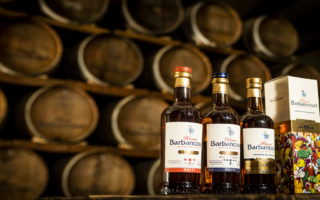Rebellious Winemakers
The French have classified their vineyards for more than a thousand years, ever since Benedictine monks who settled in Burgundy in the 10th century carved up, analysed and ordered their vineyards. They discovered that the taste of the wines changed dramatically according to where their grapes were planted; thus the notion of terroir was born.
By the 19th century, many French regions had established worldwide reputations for their wines, but fraud was rife. Burgundy was routinely fattened up with juice from the south of France, while Bordeaux was heavily cut with wines from inland. Foodstuffs such as meat, cheese and butter from specific regions also suffered, so in 1919, the Law for the Protection of the Place of Origin was passed. Then in 1923, a young lawyer, Baron Pierre Le Roy de Boiseaumarie, drew up the basis of what would become the first wine appellation d’origine contr�l�e, Ch�teauneuf-du-Pape. The Baron, who had just taken over the reins at Ch�teau Fortia, proposed that Ch�teauneuf-du-Pape be made only from grapes grown on “land arid enough to support both lavender and thyme”. Furthermore, he insisted that the village’s wines be blended from a list of ten permitted grape varieties (to which three were later added), from vines pruned in a specific way, with set maximum yields. Crucially, both alcohol level and the finished wine’s quality were to be measured for it to qualify for its appellation.
His work secured Ch�teauneuf-du-Pape’s reputation and laid the foundations for the Institut National des Appellations d’Origine (INAO) in 1935. A branch of the French Ministry of Agriculture, the INAO began the long process of officially classifying France’s vineyards, which set the benchmark for the rest of Europe. At the top of the quality tree were wines entitled to appellation d’origine contr�l�e, with the addition in 1949 of a small number of vins d�limit�s de qualit� sup�rieure, from winemaking zones waiting to qualify for full appellation status. For decades, all other wines were simply called vins de table, for which few regulations existed.
By the 1970s, many wine producers, particularly those whose vineyards fell outside the appellation boundaries, were lobbying for a new way of selling their wines, since the basic vin de table nomenclature was of little commercial value. It led to an intermediary category, vin de pays, to denote a wine from a specific region, made from grape varieties grown on soils, or using methods, not permitted by appellation regulations.
The introduction of vin de pays paid dividends ten years later when winemakers from Australia and the United States started exporting keenly priced wines, sold under the names of their grape varieties and aimed at France’s European markets. In the 1990s, the Midi reacted with vin de pays d’Oc, which promised New World charm and value with a French accent. Unlike most appellation wines, vins de pays could display the grape varieties and so compete equally with New World chardonnays, merlots and cabernet sauvignons.
The libertarian spirit that gave birth to the vin de pays category led France’s more rebellious winemakers to question the wisdom of the strict appellation laws. Some followed their counterparts in Tuscany, who declassified their more expensive ‘Super Tuscans’ to table wine status to let them make experimental blends.
I visited self-declared vigneron rebelle Jean-Paul Luc at his Villa Minna estate near Saint-Cannat in Provence. He took it over from his grandfather in 1987, two years after Coteaux-d’Aix-en-Provence was promoted from a VDQS to an AOC. At that time, the family’s vineyards were in ruin, so their greater part was not classified in the new appellation. Jean-Paul is so convinced, however, that his unclassified vineyards are superior to those within the appellation that he still sends what he harvests as Coteaux-d’Aix to the local cooperative cellar and bottles his own wines as vin de table or vin de pays.
“I would happily have made my best wines within the appellation,” Jean-Paul said, “but the classification made this impossible. Now I’m proud to be one of a group of vignerons who make top-quality wines outside of appellation regulations, notably from grape varieties not accepted by the establishment.”
The Villa Minna reds are blended from cabernet sauvignon, syrah and mourv�dre; whites are made from vermentino (rolle), marsanne and roussanne. These are traditionally made wines, barrel-aged, unfiltered and left in bottle for five years before sale. For legal reasons, the word ‘villa’ cannot be used on a bottle of vin de table, so Jean-Paul bottles his wines as ‘Minna Vineyard’ after his wife – the Anglo-Saxon touch designed to prickle the French establishment and attract foreign merchants.
By the end of 2012, a two-year overhaul of France’s wine classifications will be complete. Appellation d’origine contr�l�e will have been replaced by the almost identical appellation d’origine prot�g�e (AOP) and VDQS will cease to exist. Vin de pays will be known as indication g�ographique prot�g�e (IGP). Most radical is the new recognition given to vin de table. As vin de France, these wines can for the first time display the grape varieties and vintage on the label although their grapes may still be sourced from anywhere in France.
www.villaminnavineyard.fr
Share to: Facebook Twitter LinkedIn Email


